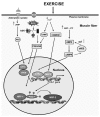Mediators of Physical Activity Protection against ROS-Linked Skeletal Muscle Damage
- PMID: 31226872
- PMCID: PMC6627449
- DOI: 10.3390/ijms20123024
Mediators of Physical Activity Protection against ROS-Linked Skeletal Muscle Damage
Abstract
Unaccustomed and/or exhaustive exercise generates excessive free radicals and reactive oxygen and nitrogen species leading to muscle oxidative stress-related damage and impaired contractility. Conversely, a moderate level of free radicals induces the body's adaptive responses. Thus, a low oxidant level in resting muscle is essential for normal force production, and the production of oxidants during each session of physical training increases the body's antioxidant defenses. Mitochondria, NADPH oxidases and xanthine oxidases have been identified as sources of free radicals during muscle contraction, but the exact mechanisms underlying exercise-induced harmful or beneficial effects yet remain elusive. However, it is clear that redox signaling influences numerous transcriptional activators, which regulate the expression of genes involved in changes in muscle phenotype. The mitogen-activated protein kinase family is one of the main links between cellular oxidant levels and skeletal muscle adaptation. The family components phosphorylate and modulate the activities of hundreds of substrates, including transcription factors involved in cell response to oxidative stress elicited by exercise in skeletal muscle. To elucidate the complex role of ROS in exercise, here we reviewed the literature dealing on sources of ROS production and concerning the most important redox signaling pathways, including MAPKs that are involved in the responses to acute and chronic exercise in the muscle, particularly those involved in the induction of antioxidant enzymes.
Keywords: Nrf2; PGC-1; UCPs; cancer; cardiovascular disease; exercise; insulin resistance; mitochondria; neurodegenerative disorders; oxidative stress.
Conflict of interest statement
The authors declare no conflict of interest.
Figures



Similar articles
-
Redox Mechanism of Reactive Oxygen Species in Exercise.Front Physiol. 2016 Nov 7;7:486. doi: 10.3389/fphys.2016.00486. eCollection 2016. Front Physiol. 2016. PMID: 27872595 Free PMC article. Review.
-
Reactive oxygen species: impact on skeletal muscle.Compr Physiol. 2011 Apr;1(2):941-69. doi: 10.1002/cphy.c100054. Compr Physiol. 2011. PMID: 23737208 Free PMC article. Review.
-
Effects of Exercise-Induced ROS on the Pathophysiological Functions of Skeletal Muscle.Oxid Med Cell Longev. 2021 Oct 1;2021:3846122. doi: 10.1155/2021/3846122. eCollection 2021. Oxid Med Cell Longev. 2021. PMID: 34630848 Free PMC article. Review.
-
Exercise-induced oxidative stress: cellular mechanisms and impact on muscle force production.Physiol Rev. 2008 Oct;88(4):1243-76. doi: 10.1152/physrev.00031.2007. Physiol Rev. 2008. PMID: 18923182 Free PMC article. Review.
-
Acute exercise stress promotes Ref1/Nrf2 signalling and increases mitochondrial antioxidant activity in skeletal muscle.Exp Physiol. 2016 Mar;101(3):410-20. doi: 10.1113/EP085493. Epub 2016 Jan 23. Exp Physiol. 2016. PMID: 26682532
Cited by
-
Effects of high-intensity interval training on physical performance, systolic blood pressure, oxidative stress and inflammatory markers in skeletal muscle of spontaneously hypertensive rats.PLoS One. 2025 Feb 4;20(2):e0316441. doi: 10.1371/journal.pone.0316441. eCollection 2025. PLoS One. 2025. PMID: 39903719 Free PMC article.
-
Quercetin Supplementation Improves Neuromuscular Function Recovery from Muscle Damage.Nutrients. 2020 Sep 17;12(9):2850. doi: 10.3390/nu12092850. Nutrients. 2020. PMID: 32957571 Free PMC article. Clinical Trial.
-
The Role of Oxidative Stress in Skeletal Muscle Myogenesis and Muscle Disease.Antioxidants (Basel). 2022 Apr 11;11(4):755. doi: 10.3390/antiox11040755. Antioxidants (Basel). 2022. PMID: 35453440 Free PMC article. Review.
-
Exercise and Exercise Mimetics for the Treatment of Musculoskeletal Disorders.Curr Osteoporos Rep. 2022 Oct;20(5):249-259. doi: 10.1007/s11914-022-00739-6. Epub 2022 Jul 26. Curr Osteoporos Rep. 2022. PMID: 35881303 Free PMC article. Review.
-
Exercise Mediates Heart Protection via Non-coding RNAs.Front Cell Dev Biol. 2020 Mar 20;8:182. doi: 10.3389/fcell.2020.00182. eCollection 2020. Front Cell Dev Biol. 2020. PMID: 32266263 Free PMC article. Review.
References
-
- Kruk J. Physical activity in the prevention of the most frequent chronic diseases: An analysis of the recent evidence. Asian Pac. J. Cancer Prev. 2007;8:325–338. - PubMed
Publication types
MeSH terms
Substances
LinkOut - more resources
Full Text Sources
Medical

